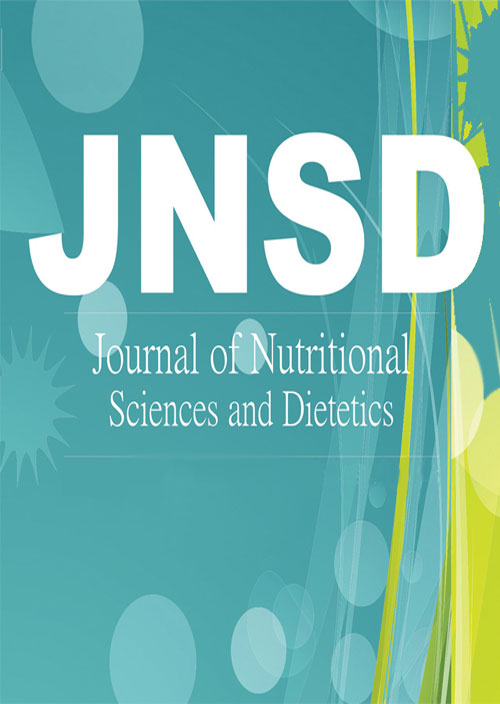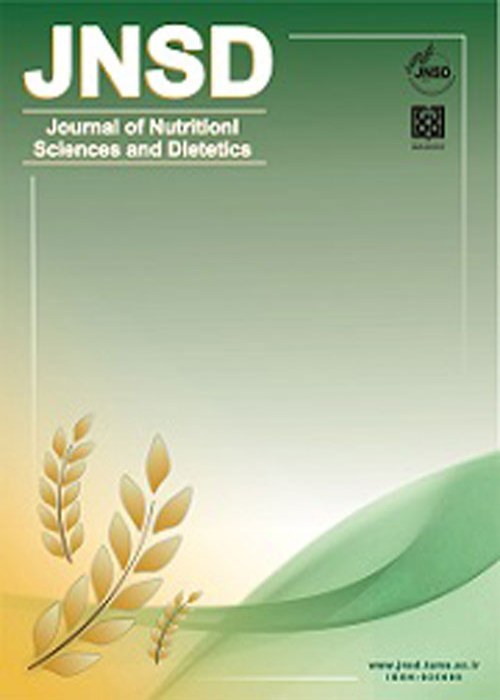فهرست مطالب

Journal of Nutritional Sciences and Dietetics
Volume:5 Issue: 3, Summer- Autumn 2019
- تاریخ انتشار: 1401/10/01
- تعداد عناوین: 6
-
-
An Investigation into The State of Anxiety, Depression, and Quality of Life in Overweight and Obese PeoplePage 275Background
Obesity is considered a source of psychological distress.
ObjectiveThis study aims is investigating anxiety, depression, and the quality of life in people with obesity and overweight living in Rasht, North Iran.
MethodsThis analytical cross-sectional research was carried out on 134 subjects between 18 and 45 years old who had referred, for the first time, to the Nutrition Ward of Subspecialty Clinic Beesat in Rasht in 2017-18 with overweight or obesity. The Beck Depression Inventory (BDI), the Beck Anxiety Inventory (BAI) and a questionnaire of health-related quality of life known as the 36-Item Short Form Health Survey(SF-36) were used to identify the subjects’ level of depression, anxiety, and quality of life. The collected data were analyzed in SPSS 23.
ResultsTotally, 49 overweight (36.6%) and 85 obese patients (63.4%) were investigated. 46 (34.4%) suffered from moderate to severe anxiety and 38 (28.4%) had moderate to severe depression. Furthermore, the average score of quality of life was 65.54 ± 17.37. There was a significant difference in terms of anxiety and quality of life between overweight and obese people. Also, out of the 8 dimensions of quality of life, physical function and general health had a significant negative correlation with BMI. No significant relationship was found between obesity and depression.
ConclusionAn increase in BMI leads to a rise in anxiety and a decrease in the quality of life. By considering the role of psychological factors in obesity, mental health interventions can prevent and control this condition and improve people’s quality of life.
Keywords: Obesity, overweighting, depression, anxiety, quality of life -
Interactive Effects of Endurance Training and Selenium Consumption on the Intrinsic Apoptosis Pathway in the Liver Tissue of Cadmium-Exposed RatsPage 276Background
Cadmium can damage various tissues, including the liver, by fragmenting DNA of cells through increasing free radicals and reactive oxygen species (ROS) as well as inhibition of apoptotic suppressor proteins.
ObjectivesThe purpose of this study was to investigate the interactive effects of endurance training and selenium consumption on the intrinsic apoptosis pathway in the liver tissue ofcadmium-exposed rats.
MethodsIn this experimental study, 30 rats were selected and divided into six groups of five subjects: (1) control, (2) selenium consumption, (3) high intensity interval training (HIIT), (4) continuous training, (5) HIIT with selenium, and (6) continuous trainingwithselenium.All rats peritoneally received 2 mg/kg of body weight cadmium for eight weeks. Rats in groups 2, 5 and 6 received0.23 mg/kg of selenium daily.Also, groups 3 to6 performed three sessionsof continuous and high intensity interval training for eight weeks. Two-way ANOVA along with Bonferroni's pairwise comparison test was used to analyze the findings of the research (P≤0.05).
ResultsTraining increased Bcl-2 in the liver tissue of cadmium-exposed rats (p≤0.05);also, HIIT had a greater effect on Bcl-2 than continuous training (p ≤0.05).Selenium consumption reduced Bax and increased Bcl-2 in the liver tissue of cadmium-exposed rats (p≤0.05); on the other hand, exercise trainingand selenium consumption had interactive effects on decreasing caspase-9 and Bax and increasing Bcl-2 expression in the liver tissue of rats exposed to cadmium (p ≤0.05).
ConclusionsEndurance training along with selenium consumption seems to have interactive effects on improving the process of liver apoptosis in rats exposed to cadmium.
Keywords: Training, Selenium, Apoptosis, Liver -
Effect of Tart Cherry supplementation on exercise-induced muscle damage in athletes: A systematic review and meta-analysis of randomized clinical trialsPage 282Background
Tart Cherry (TC) is recommended for muscle damage and delayed onset muscle soreness (DOMS); however, the evidence is uncertain. The purpose of this study was to determine the effects of TC on delayed onset muscle soreness (DOMS) and Creatine kinase (CK).
MethodsRandomized Controlled Trials (RCTs) were extracted from a literature search of online databases (PubMed and Scopus) performed up to September 5, 2018. Mean differences (MDs) with 95% confidence interval (CI) between TC and placebo using random effects analysis.
ResultsIn total, eight trials met the inclusion criteria including 189 athletes (TC 92, placebo 97). Pooling data showed plasma CK activity was reduce after TC supplementation at three follow-up times (24h: MD: -1.22, 95% CI: −1.85 to -0.59, p = 0<001, 48h: MD: -0.97 to 95% CI: -1.36 to -0.59, p = 0<001and more than 48 h: MD: -0.81 to 95% CI: -1.31 to -0.30, p = 0<001) in comparison to placebo group. There were no significant changes in DOMS between intervention and control groups in three times (24: MD: -0.79, 95% CI: −1.72 to 0.15, p = 0.98, 48h: MD: -0.72 to 95% CI: -2.29 to 0.85, p = 0.36 and >48h: MD: -0.06, 95% CI: −0.81 to 0.69, p = 0.87).
ConclusionOverall, our analysis supports tart cherry use for reducing Creatine kinase level after exercise. However, Tart cherry supplementation had no significant effect on DOMS. Additional research is required to determine effect of TC on muscle damage and DOMS in animals and humans.
Keywords: Tart Cherry, muscle damage, Creatine kinas, delayed onset muscle soreness, meta-analysis -
The Effects of vitamin D supplementation on lipid and inflammatory profile of healthy adolescent boysPage 287Background
Deficiency of Vitamin D, an anti-inflammatory micronutrient with some favorable effects on lipid profiles, has been found to be highly prevalent in adolescents. We aimed to investigate the effect of a high-dose vitamin D supplementation on the lipid and inflammatory profiles of healthy adolescent boys.
MethodsIn this randomized double-blind placebo-controlled trial, sixty healthy adolescent boys (age 17 yr) were recruited from one high school in Tehran, Iran and randomly assigned to two groups. The supplement group received vitamin D pearls at a dose of 50,000 IU monthly for 6 months and the other group was given placebo pearls for the same duration. Before and after the treatment, the serum levels of 25-hydroxy vitamin D (25(OH) D), parathyroid hormone (PTH), retinol, lead (Pb), the lipid profile and inflammatory biomarkers were measured and compared.
ResultsBetween groups statistical analysis showed that a high dose (50,000 IU/month) vitamin D significantly increased and decreased serum levels of vitaamin D and PTH, respectively (P < 0.05). No significant change was observed in serum levels of retinol and Pb. Between-group analysis revealed that the serum levels of TG and HDL decreased and increased, respectively (P < 0.05). Both the within- and between-group analysis showed that serum tumor necrosis factor receptor 2 (TNFR2) concentration declined while serum interleukin-10 (IL-10) increased in response to vitamin D supplementation (P < 0.05).
ConclusionA high dose (50,000 IU/month) Vitamin D supplement seems to have some positive impact on serum vitamin D, lipid profile and inflammatory biomarkers in healthy adolescent boys.
Keywords: Adolescent, Inflammation, Lipid profile, PTH, Vitamin D -
The effectiveness of Vitamin C on the Level of Salivary Total Antioxidant Capacity (TAC) in bruxism patients with pain: a randomized clinical trialPage 288Introduction
Bruxism is a para-functional disorder and the prevalence of this rhythmic activity of masticator muscles is 8-31.4%. The exact pathophysiology of bruxism is still unclear. For this reason, traditional treatments such as splint bite are not always effective and can lead to complications such as increased pain during the patient’s rest. Based on the fact that the oxidative stress imbalance leads to tissue damage and is a life-threatening factor, and as it has recently been announced that there is an imbalance in the oxidative stress and reduction of antioxidants in people suffering from bruxism, in this research the effectiveness of Vitamin C was evaluated on the level of Salivary Total Antioxidant Capacity (TAC) in bruxism patients for diagnostic and treatment purposes.
Materials & MethodsThirty patients with bruxism were selected for this double-blind, placebo-controlled study. The patients were randomly divided into two groups who used vitamin C 250 mg/day (n=15) and placebo (n=15) for one month. The measurement of TAC as well as the amount of pain based on the Numerical Rating Scale (NRS) was performed before the onset of drug therapy and at the end of the first month. The statistical analysis was performed using ANOVA test and Repeated Measure ANOVA.
ResultsBased on the observations, there was no significant difference between the TAC of stimulated (p=0.12) and un-stimulated (P=0.13) saliva as well as pain (p=0.48) after intervention between the two considered groups (group receiving vitamin C and group receiving placebo in bruxism patients). The results obtained from pre- and post-intervention indicated that TAC of un-stimulated saliva (P=0.73) and pain (P=0.94) decreased in both groups, though it was not statistically significant. On the other hand, the TAC of stimulated saliva (p=0.60) increased in the intervention group and decreased in the control group but again it was not statistically significant in both groups. No significant side effects were observed in the two groups.
ConclusionBased on this study, we found that vitamin C (250 mg/day) enhanced the total antioxidant capacity (TAC) of stimulated saliva. However, statistically it did not make any significant changes in stimulated and un-stimulated saliva in patients with bruxism. Further, it reduced pain in these patients which was not statistically significant either. Numerous studies have demonstrated that oxidant and antioxidant imbalance is associated with bruxism. Nevertheless, so far it has not been determined whether oxidative imbalance leads to bruxism or vice versa. Therefore, it can be concluded from this study that oxidant imbalance in the pathogenesis of bruxism does not play a significant role and perhaps patients suffer from decreased antioxidant capacity after bruxism. In this case, vitamin C or other antioxidant supplements are advised to prevent harmful effects of diminished body’s antioxidant capacity. Still, it is recommended to perform studies with a longer follow-up and larger sample size and higher dose of vitamin C, even in combination with other antioxidant supplements, in order to obtain more reliable results.
Keywords: bruxism, antioxidant, vitamin C, saliva -
Comparison of carbohydrate quality index amongst nurses with and without premenstrual syndrome: a case-control studyPage 298Background and Objectives
Due to lack of adequate evidence on the association between intake of carbohydrate and risk of premenstrual syndrome, we aimed to address this issue by analyzing the carbohydrate quality index amongst nurses with and without premenstrual syndrome as a stress intensive career group.
MethodsWe examined 151 nurses with and 156 nurses without premenstrual syndrome in current study (totally: 307). Data were collected through interviews using socio-demographic questionnaire, Pre-menstrual Symptom Scale, Food Frequency Questionnaire and International Physical Activity Questionnaire. The carbohydrate quality index was calculated by sum of scores including solid carbohydrate/total carbohydrate, total dietary fiber, GI, and whole grains/total grains. We were utilized Independent sample t-test, Chi-square, One-way analysis of variance, analysis of Covariance and Logistic regression tests to analyze the data.
ResultsAfter adjusting for covariates, participants in the highest quartile of carbohydrate quality index had lower odds ratio of premenstrual syndrome (odds ratio: 0.97, confidence interval: 0.50-1.86) compared with the lowest quartile. However, this difference was not significant (P-trend=1.0). In addition, no relationship was found between premenstrual syndrome and carbohydrate quality index subscales including glycemic index, solid carbohydrate/total carbohydrate, total dietary fiber, and whole grains/total grains.
ConclusionsThere is no relationship between different dietary carbohydrate indices and premenstrual syndrome, although further studies are needed to fully determine the possible associations.
Keywords: Carbohydrate Quality Index, Case Control Study, Premenstrual Syndrome


